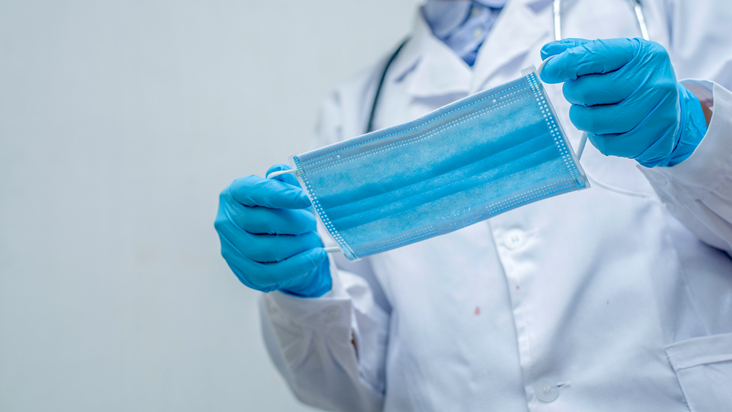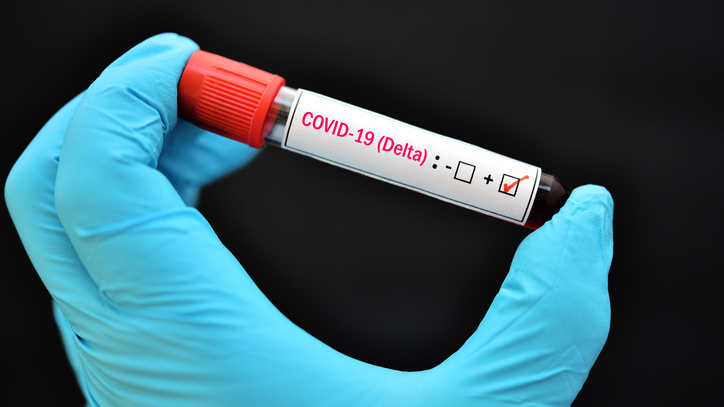
A mask in a doctor's hand. /Getty
A mask in a doctor's hand. /Getty
Editor's note: Zhu Huachen is an associate professor at the State Key Laboratory of Emerging Infectious Diseases, The University of Hong Kong. This is the second piece of the author's series on the origins of COVID-19. The article reflects the author's opinions and not necessarily the views of CGTN.
It has been 20 months since the first confirmed case of COVID-19 was recorded in Wuhan, one of the most populous cities in central China. In the past year, Wuhan's Huanan seafood market where the earliest cluster of human cases was reported was closed. Viruses were not found in animals sold at this market, but environmental samples were positive.
The initial epidemic has then developed into a global pandemic and billions of people have now been either vaccinated or infected. Seroconversions were seen in these individuals, making the earliest cases undifferentiated if tested by serum antibodies.
Reverse zoonotic spillover from humans to animals have also been documented, but the closest animal virus that has been detected in nature was the RaTG13 collected in 2013 from a bat, which only has a 96.1 percent genome identity to SARS-CoV-2.
It seems that we have missed the golden opportunity to identify the early origin of this emerging SARS-CoV-2 virus and the direct source of human infections from its animal reservoir. With this virus spreading now to almost everywhere in the human populations, is there any chance left for us to reveal how this virus was generated?
As a scientist working on the virus evolution and ecology, my answer is "Yes."
We still have the chance, but international cooperation and a more open, collaborative atmosphere need to be warranted. A well-designed investigation with a reasonable hypothesis will help with the conduct of the research. Stigmatization of the origin and smear of the efforts from those who are trying to reveal the truth must be stopped.
So, how can we reveal the genesis of COVID-19 virus?
First, a thorough surveillance in the animal hosts across different countries and regions is required to understand the ecology of SARS-related viruses.
Up to date, the closest relative to SARS-CoV-2 remains to be the RaTG13 from a horseshoe bat (Rhinolophus affinis) sampled in Yunnan, China. The four percent difference at the whole genomic level allows different hypotheses about how these two viruses are related to each other.
However, one important fact that is worth noticing is that RaTG13 is not the direct precursor of SARS-CoV-2 virus. Indeed, these two viruses diverged from a common ancestor decades ago, and they fall into different sister groups on the phylogenetic tree. They were not mother and son; rather, they were more like aunt and nephew.
In the infamous SARS-related virus clan (also known as Sarbecovirus or beta 2 coronavirus lineage), there are virus members discovered in bats from Kenya, Russia, Bulgaria, United Kingdom, Japan, Thailand, Cambodia and different provinces in China. Thus, this virus lineage is inter-continentally distributed, but viral sequences are still quite limitedly available so far.
Apart from bats and pangolins, from which SARS-CoV-2-related viruses have been repeatedly isolated, many animals (minks, cats, dogs, tigers and lions, raccoon dogs, ferrets, hamsters, and non-human primates) are also found to be susceptible to the SARS-CoV-2 virus.
This implies that the natural hosts for SARS-CoV-2 may be much more diverse than we expected. So do their natural habitats.
As such, a better understanding about the global Sarbecovirus distribution and the viral genetics will inform us of its evolutionary patterns and the risks for interspecies transmissions. Serological studies in different species of animals can also help to suggest the virus prevalence in nature.

A vial of blood sample positive with Delta variant COVID-19 virus. /Getty
A vial of blood sample positive with Delta variant COVID-19 virus. /Getty
Second, retrospective studies using blood or clinical samples collected before or during the early outbreaks of COVID-19 will help to identify the previously unrecognized cases and source of infections throughout the world.
There have been multiple reports on the possible infection cases during 2019- early 2020. Seropositive samples were found from individuals from Japan, Italy, U.S. and Brazil before the first imported cases were identified in these countries. Other clinical evidence also suggests that SARS-CoV-2 virus may have been introduced into the human populations much earlier than we expected.
As COVID-19 has a very broad disease spectrum and the SARS-CoV-2 can infect the different organs and tissues in the patients, screening tests of the virus from extrapulmonary samples is necessary.
Surprisingly, traces of the SARS-CoV-2 virus have been detected in a skin biopsy from a woman in Milan who had a mild sore throat and an unusual skin condition on November 10, 2019. She was found to have COVID-19 positive antibodies a few months later.
This might be the earliest known case with positive nucleic acid report in the world, even though serological survey suggests that COVID-19 may have been prevalent in Japan before January 2019 and in Italy before September 2019.
SARS-CoV-2 virus has also been detected in sewage or other environmental samples collected in 2019 before the virus was known to cause any disease outbreak in patients. Thanks for the persistent endeavor from scientists and clinical doctors all over the world, our knowledge about the origin of COVID-19 continues to be updated.
Third, in silico, in vitro and in vivo analysis should be conducted by interdisciplinary researchers to confirm the virus evolutionary patterns and its possible genesis.
Viruses speak as their evolutionary histories are mostly recorded in their genomes. Sophisticated bioinformatic analysis can help to dig out a lot of the hidden truth, such as the transmission chain of a virus, or the selection pressures posed by the host. You can even use the available data to infer the sequence of a possible ancestor.
In particular, as a highly mutative RNA virus, coronavirus adapts to its hosts much faster than the organisms that possess a DNA genome. Therefore, signatures conferred by the host cells during the virus replication will be documented in the viral genome, revealing some clues of the infection history.
For example, it has been found that a large proportion of sequence change in human SARS-CoV-2 are C→U mutations. This might be associated with the host antiviral editing mechanism against coronaviruses.
Moreover, signals of stronger purifying selection pressure and mutation signature caused by deactivity of an RNA exoribonuclease were detected when comparing the SARS-CoV-2 with the RaTG13 sequence.
Recently, it was noticed that some scientists have started to use the different cellular or animal models to simulate the virus evolution and adaptation in different hosts.
Gradually, our knowledge about the COVID-19 is accumulating and advancing, creating new opportunities for us to combat the virus.
For the scientific community, all the evidence-based perspectives and hypotheses with rational reasoning are respected and welcomed. But unprovoked framing and unfounded allegations must be stopped, as they will not just impede the progress and motivation of research. Instead, they will create hatred and a very toxic air that leads us to another form of fatal infection - where we will end up with meaningless fighting, endless suspicions, and groundless accusation.
Let science be science. Let researchers utilize their ingenuity to solve problems instead of the trumped-up charges. Let the "Four-C Model" (communication, coordination, cooperation and collaboration) help us out of the muddy troubles.
(If you want to contribute and have specific expertise, please contact us at opinions@cgtn.com.)

